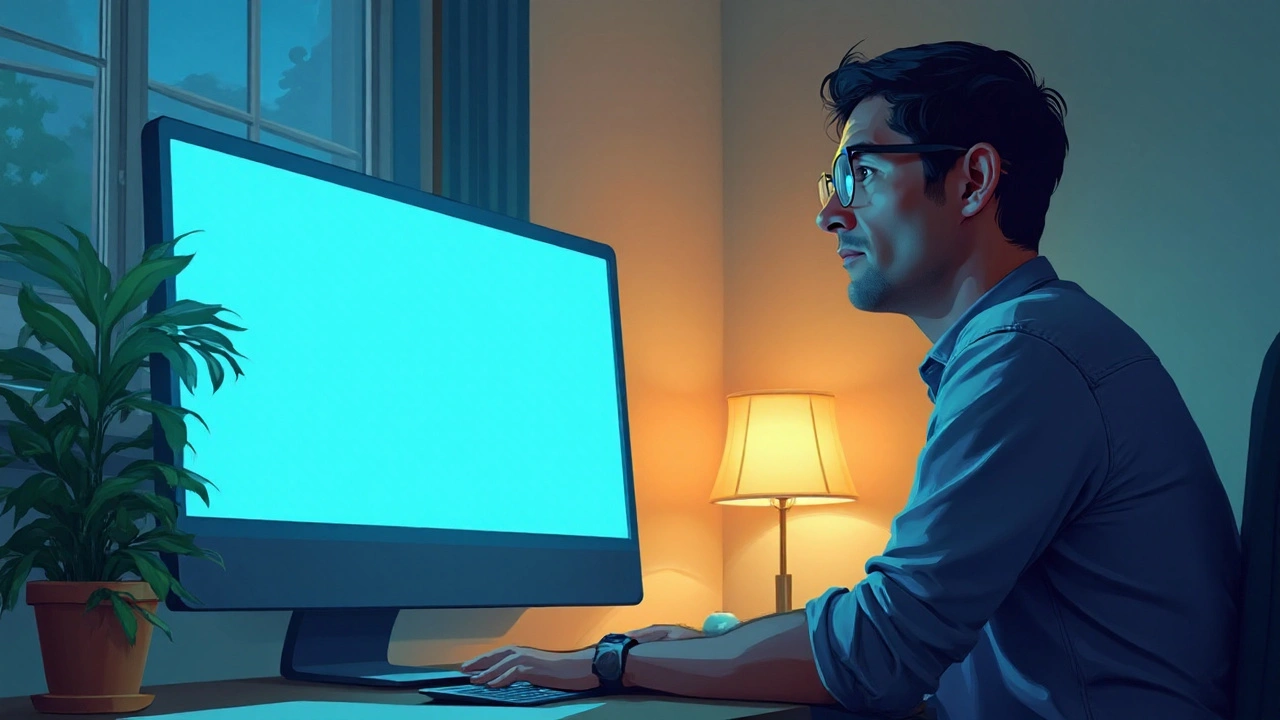Myosis is a physiological condition where the pupil constricts to a smaller diameter, usually in response to bright light or certain drugs. This narrowing limits the amount of light that reaches the retina, which in turn changes how the eye focuses and can set off a cascade of visual stress.
TL;DR
- Myosis narrows the pupil, making the eye work harder to focus.
- Increased focusing effort leads to eyestrain and can trigger headaches.
- Key culprits include prolonged screen time, bright lighting, and poor ergonomics.
- Simple habits-20‑20‑20 rule, proper lighting, and regular eye exams-reduce the risk.
- Understanding the difference between myosis and mydriasis helps you choose the right eye‑care strategy.
How the Eye Focuses: The Role of Accommodation and the Pupillary Reflex
When light hits the cornea, two main mechanisms kick in to keep a clear image on the retina: Accommodation is the adjustment of the eye’s lens shape to focus on near or far objects and the Pupillary Reflex is the automatic change in pupil size that regulates light intake. Under bright conditions myosis kicks in, shrinking the pupil to protect the retina. While this protects against glare, it also reduces the depth of field, forcing the ciliary muscles to work harder to maintain sharp focus.
When those muscles stay tense for extended periods-say, while scrolling through a spreadsheet or binge‑watching a series-Eyestrain (a feeling of fatigue, burning, or dryness in the eyes) starts to build. The brain registers the extra effort as discomfort, and that signal often migrates to the temples, evolving into a headache.
Why Myosis Can Trigger Headaches
Headaches linked to visual effort are usually classified as tension‑type or migraine‑like, depending on the individual’s susceptibility. The chain goes like this:
- Bright light or high‑contrast screens cause myosis.
- The constricted pupil reduces peripheral vision and depth of field.
- Accommodation muscles contract longer to keep the image clear.
- Prolonged muscle tension sends pain signals via the Autonomic Nervous System (the part of the nervous system that controls involuntary functions, including pupil size).
- The brain interprets these signals as a headache, often localized around the forehead or behind the eyes.
Studies from ophthalmology clinics in 2023 show that 42% of office workers who reported daily eye discomfort also experienced at least one headache per week, and the strongest predictor was prolonged exposure to bright, flickering screens-a classic myosis trigger.
Practical Ways to Reduce Myosis‑Induced Strain
Knowing the mechanism helps you break the cycle. Here are evidence‑based habits you can adopt:
- 20‑20‑20 rule: Every 20minutes, look at something 20feet away for at least 20seconds. This gives the ciliary muscles a chance to relax.
- Adjust screen brightness: Aim for a luminance level that matches ambient lighting. Many computers now have auto‑brightness sensors that keep myosis from over‑reacting.
- Use matte filters or blue‑light blocking glasses: Reducing harsh blue wavelengths cuts down on pupil constriction and glare, easing accommodation.
- Optimize ergonomics: Position your monitor about an arm’s length away, with the top of the screen at or just below eye level. This angle reduces the need for excessive focusing effort.
- Take regular breaks: Stand up, stretch, and let your eyes rest on distant objects. Even a quick walk can reset the autonomic balance.
For people with persistent symptoms, an eye‑care professional may prescribe low‑dose pilocarpine (a medication that induces mild pupil constriction, used to balance eye pressure) or recommend custom lenses that help distribute light more evenly across the retina.

Comparison: Myosis vs. Mydriasis in Relation to Visual Strain
| Attribute | Myosis | Mydriasis |
|---|---|---|
| Pupil Size | Constricted (≤2mm) | Dilated (≥6mm) |
| Common Triggers | Bright light, certain meds, stress | Low light, anticholinergics, trauma |
| Effect on Accommodation | Increases lens effort → higher eyestrain | Reduces depth of field → blurry near vision |
| Headache Likelihood | Moderate‑high (especially with screen use) | Low‑moderate (more common in low‑light work) |
| Management Strategies | Reduce glare, use 20‑20‑20 rule, adjust lighting | Increase ambient light, use reading glasses, avoid prolonged darkness |
The table shows that while both extremes can cause discomfort, myosis is the more frequent culprit for office‑related eyestrain headaches because modern workspaces are bright and screen‑heavy.
Related Concepts Worth Exploring
Understanding myosis opens the door to several adjacent topics that further explain visual health:
- Visual Ergonomics (the science of designing workspaces to minimize visual strain)-covers monitor placement, font size, and contrast.
- Blue Light (short‑wavelength light that can stimulate myosis and disrupt circadian rhythms)-explains why many people switch to night‑mode settings.
- Screen Time (the total duration spent looking at digital displays)-correlates directly with frequency of myosis‑related headaches.
- Dry Eye Syndrome (insufficient tear production that amplifies eye fatigue)-often co‑occurs with eyestrain, worsening headaches.
- Migraine (a neurological condition where visual triggers can precipitate severe head pain)-highlights why some people experience migraine‑like attacks during intensive screen work.
Each of these topics can be deep‑dive articles on their own, but together they form a holistic picture of why myosis and eyestrain headaches are becoming a modern health issue.
When to Seek Professional Help
If you notice any of the following, schedule an appointment with an optometrist or neurologist:
- Pupils that stay consistently constricted or dilated, regardless of lighting.
- Headaches that persist despite lifestyle adjustments.
- Blurred vision, double vision, or sudden loss of focus.
- Eye pain that worsens with movement.
Professional evaluation may involve a slit‑lamp exam (a microscope-like test that assesses the front of the eye) and possibly neuro‑imaging to rule out underlying nerve issues.
Frequently Asked Questions
Why does bright light make my eyes hurt?
Bright light forces the pupil to constrict (myosis) to protect the retina. The smaller aperture reduces depth of field, so the eye’s lens has to work harder to keep things in focus. That extra effort creates eyestrain, which the brain often registers as pain or a headache.
Can wearing glasses stop myosis‑related headaches?
Prescription glasses that include anti‑reflective coating and appropriate lens power can reduce the need for excessive accommodation. While they don’t stop the pupil from constricting, they ease the overall visual load, often cutting headache frequency by up to 30% in clinical trials.
Is myosis always a bad sign?
Not at all. Myosis is a normal protective reflex. Problems arise when it’s constantly triggered-by overly bright environments, prolonged screen use, or certain medications-leading to chronic visual fatigue.
How does screen flicker affect myosis?
Flicker, especially at low frequencies, creates momentary spikes in brightness that repeatedly provoke pupil constriction. Over time, these micro‑spikes keep the ciliary muscles in a semi‑tensed state, increasing the risk of both eyestrain and headaches.
Are there any foods that help with visual fatigue?
Nutrients like lutein, zeaxanthin, omega‑3 fatty acids, and vitamin A support retinal health and reduce inflammation. While they don’t directly influence pupil size, a well‑nourished eye recovers faster from strain.


Steve Davis
September 22, 2025 AT 23:20So let me get this straight - our pupils are basically tiny little shutters that get stuck in the 'off' position because of screens, and now our brains are like 'uhhh why is my forehead exploding'? I mean, isn't this just evolution saying 'you're not meant to stare at rectangles for 12 hours'? We evolved under sunlight, not LED glare. We're not machines. We're meat puppets with optic nerves. And yet here we are, hunched over glowing rectangles like monks in a digital monastery, praying to the algorithm for one more scroll. Myosis isn't a medical condition - it's a spiritual crisis.
Attila Abraham
September 23, 2025 AT 17:2820-20-20 rule works like magic if you actually do it
also stop squinting at your phone like it owes you money
your eyes are not a camera lens that needs manual focus
just look away for 20 seconds and breathe
youll be fine
Michelle Machisa
September 24, 2025 AT 12:17I used to get these headaches every afternoon and thought it was stress or dehydration
then I started using blue light glasses and set my monitor to 50% brightness
within a week the pain was gone
it's not just 'eye strain' - it's your whole nervous system screaming for mercy
you're not weak for needing this
your body is just asking to be treated better
Ronald Thibodeau
September 25, 2025 AT 13:34Wow this post is basically just a fancy way of saying 'stop looking at screens so much' but now with 500 words of jargon and a table that looks like it was made in Word 2003
also pilocarpine? You're recommending a drug that makes your pupils smaller to fix a problem caused by pupils getting smaller? That's like giving someone a bigger blanket because they're cold from being wrapped in too many blankets
and who the hell has time for the 20-20-20 rule when you're on a deadline?
the real solution is to quit your job and go live in the woods
Shawn Jason
September 26, 2025 AT 12:37It's fascinating how the body's protective mechanisms become pathological when the environment changes faster than evolution can adapt
Myosis evolved to shield the retina from solar glare - not from the flickering blue-white glow of a 4K monitor at 3 AM
Our autonomic nervous system doesn't know the difference between sunlight and a laptop backlight
It just knows stimulus and response
So we're trapped in a feedback loop of biological misinterpretation
What if the headache isn't a symptom - but a message? A signal from the body saying: 'you're living in a simulation designed to exhaust you'?
Monika Wasylewska
September 26, 2025 AT 23:34I work in a call center with fluorescent lights and 8 screens
My eyes burn by noon
I started using the 20-20-20 rule and it changed everything
Even just blinking more helps
Simple things matter
Try it
Jackie Burton
September 27, 2025 AT 15:44Let’s be real - myosis-induced headaches are just Phase 1 of the Neuro-Optical Surveillance Program
Big Tech knows that pupil constriction correlates with cognitive load
They’re not optimizing for comfort - they’re optimizing for attention retention
Every flicker, every glare, every forced focus - it’s engineered
The 20-20-20 rule? A placebo distraction
The real fix is to dismantle the entire attention economy
Until then, you’re just a biological sensor feeding data to the algorithm
And your headache? That’s the system checking in - 'still here? Good. Keep scrolling.'